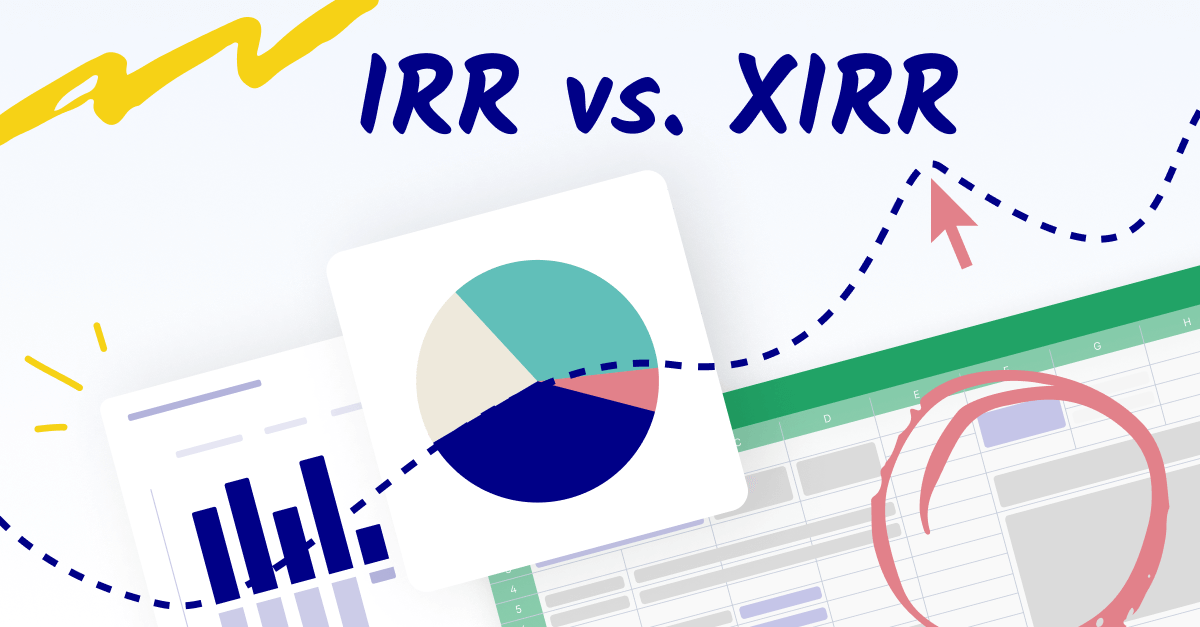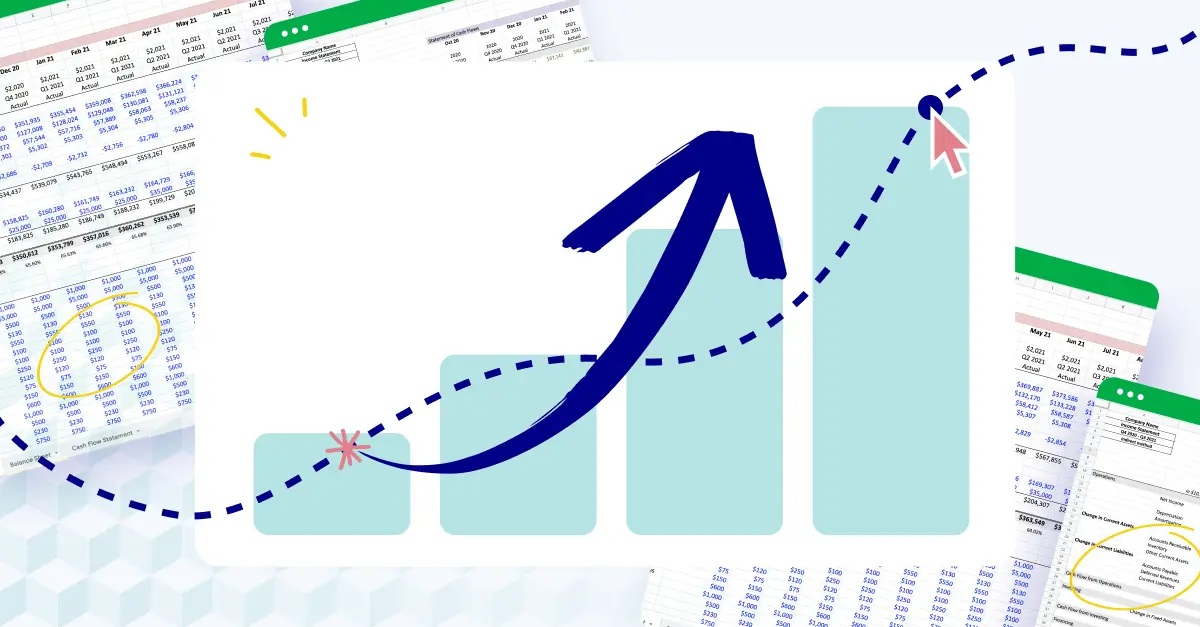What is capital budgeting?
Capital budgeting is the process of evaluating and selecting long-term investment projects that require significant amounts of capital or funds. These projects (e.g., acquiring another company or purchasing fixed assets like machinery) are known as capital expenditures.
The capital budgeting process helps businesses determine which projects or investments to pursue based on their potential profitability, risk factors, and alignment with the company's current financial capacity and long-term objectives.

Capital budgeting: it's all about the cash flows
Capital budgeting is based on one unavoidable fact: a company has limited financial resources.
Not every project that comes to the table can be executed. By comparing the expected cash flows of each project (i.e., cash inflows and outflows, including the initial investment and maintenance costs), capital budgeting helps determine where those resources are best allocated to boost profitability and maximize shareholder value.
If future cash inflows are greater than projected outflows, the project may be worth pursuing.
The capital budgeting process
The capital budgeting process is like a funnel. Ideas come in at the top and are refined and sorted as they move to the bottom. If the ideas aren't in line with an organization's capabilities or it turns out the risks outweigh the potential returns, the ideas are cut out of the process.
By the time they reach the end of the funnel, only a few capital projects are left. From here, it's up to a company's management team to decide which project is prioritized and executed.
Here’s a breakdown of the capital budgeting process:
1. Identify potential projects
When it comes to capital budgeting, the first step is to identify potential projects. Project proposals can come from any level of the company, but they must be backed up by data.
For example, since evaluating cash flow is the most important aspect of capital budgeting, you'll want to include vetted estimates of cash inflows and cash outflows in each proposal.
Next, proposals should illustrate the initial investment required for the project. This should include the costs associated with acquiring assets, equipment, or technology and any implementation or setup expenses.
You can set up screening criteria to filter out projects that don't meet certain benchmarks, such as specific hurdle rates or expected return thresholds. This way, you can create a project shortlist.
Finally, ensure the project fits the company's strategic goals and aligns with its long-term vision for growth and profitability.
2. Evaluate projects
Assess whether or not the project is feasible. Start by using one or more of the capital budgeting analysis methods (more on this later).
Remember that when evaluating projects, it's essential not only to look at cash flows or expected revenue, but also the risk of the project. Sure, a project may produce a significant return if successful. But more is needed to suggest it's a good idea, especially if there's only a 20% chance of success!
Involve relevant stakeholders from different departments when evaluating which project to select. Each department may have unique insights into why one is better.
For instance, the marketing department may provide valuable input on market potential and customer demand, while the finance department can decide whether the company can take on the required investment and financial commitments (and whether the ROI is worth it).
3. Select your project
Based on all the factors listed above, you can rank projects based on their attractiveness and make your selection from there.
However, every company is different. What's attractive to one may not be attractive to another. Some might prioritize maximizing financial returns, while others may emphasize shorter payback periods or achieving non-financial objectives, like sustainability or market share expansion.
4. Allocate resources
Once the project is approved, allocating the necessary resources is next. This involves assigning project teams with the required skills and expertise. Additionally, you'll need to establish a budget for the project and consider any financing costs that may be required.
To ensure a smooth implementation, creating a detailed plan that includes exact timelines and targets, such as specific cost reductions by a certain date, is crucial. This plan will serve as a roadmap for the project, outlining key milestones and deliverables.
5. Implement the project
Next, we move on to the fun part—implementing the project. Follow the timeline established in the previous step and ensure there's a process for recording costs and cash flows.
Throughout the implementation phase, you'll want to monitor the project's progress. Compare actual performance against the planned targets and make necessary adjustments as required.
6. Evaluate the results
The last step is to evaluate the project's performance: how did it compare with the proposal? This evaluation will help you refine your capital budgeting process, which you'll need to apply to future projects continuously.
Capital budgeting methods
Choosing the right method is essential to ensure you're making the smartest capital budgeting decisions for your business. Here are a few capital budgeting methods to consider:
Discounted cash flow method
First, we have the discounted cash flow method, which discounts future cash flows to the present date.
Discounting cash flows to the present date means adjusting their value to what they would be worth right now, while considering things like opportunity cost and risk premium. In other words, it determines their present value.
Present value is a strange concept. We know the money we have right now has value, but what about the money we will have in the future?
As a result of the principle of the time value of money, future money is worth less to us than the money we have now. This is due to factors like inflation and the loss of the opportunity to invest that money elsewhere.
Think of it this way: when it comes to investing, we understand that the money we have right now has a potential future value. For example, if we put $1,000 into a savings account with a 5% annual rate, we'd have $1,283 in five years.
Therefore, we need to work backward to figure out the present value of future cash flows. Going off the previous example, that future $1,283 is only worth $1,000 right now. That’s because to gain the extra $283, we need to invest $1,000.
Similarly, if a future cash flow on a project is estimated to be $1,000,000, you need to figure out what that amount is worth to you right now.
You can do this by using what’s known as a discount rate.
Two commonly used discount rates are the weighted average cost of capital (WACC) and the risk-free rate.
WACC is the average rate of return required by a company to fund its operations and investments. It takes into account the cost of equity and cost of debt and represents the minimum rate of return a project needs to generate to create value for the company.
You'd use this method when evaluating projects with A) a level of risk similar to that of the company at large, or B) a level of risk that would affect the company's overall capital structure.
The risk-free rate refers to the rate of return on an investment that (theoretically) has zero risk. It's typically based on the yield of U.S. government bonds or other low-risk financial instruments. It's a good idea to use this method to compare projects with different levels of risk, as it allows for a consistent comparison of risk-adjusted returns.
You'll have their present value once you have discounted the future cash flows with the appropriate discount rate.
There are two types of discounted cash flow methods: the net present value method and the internal rate of return method (more on these later). What we described in this section is the basis for both.
Net present value method
This approach aims to figure out a project's net present value (NPV). NPV is equal to the sum of the present values of all cash inflows and outflows related to a project.
To determine NPV, add up the present value of all future cash flows. Then, subtract the initial investment and any other outflows (like maintenance costs) from this number. You’re essentially comparing how much cash the project is expected to generate with how much it will cost.
Net present value analysis can involve complex calculations. It can sometimes be challenging to determine the appropriate discount rate, as it involves many metrics like the cost of capital, the risk profile of the project, and the opportunity cost of investing in alternative projects.
That said, it's critical to get the discount rate right. If it's wrong, the NPV will be flawed, potentially leading to incorrect investment decisions.
If a company follows the NPV rule, it means they're only concerned with whether the NPV of a project is positive or negative. If it's positive, they'll commence the project. If negative, they'll ignore it.
Internal rate of return
The internal rate of return (IRR) is the discount rate at which the NPV becomes zero. In other words, what rate of return do you need on the project to break even?
To figure out the internal rate of return, set up the NPV equation. Then, use trial and error (or financial software) to find the rate that makes the result zero.
The IRR can be used as an internal benchmark for companies. It helps establish a minimum required rate of return, also known as a hurdle rate. Projects must meet or exceed this rate to be considered financially viable. By using the IRR, companies can align their investment decisions with their objectives and risk tolerance.
One drawback of the IRR is that it assumes that the project's cash flows will be reinvested at the same IRR, which isn’t always realistic.
Additionally, the IRR doesn't compare the sizes of projects. Two projects with different initial investments may have different IRRs, but that doesn't tell you anything. When comparing projects of different sizes, it's better to use NPV or the profitability index instead.
Payback period method
The payback period method is a straightforward approach to capital budgeting. This technique aims to determine how long it would take a project to pay for the initial investment (or, in other words, to pay for itself).
This is usually easy to figure out based on estimated cash inflows. For instance, if an investment costs $125,000, and you expect it to generate $25,000 a year, it'll take five years to recoup your investment.
However, the payback period method does have some significant drawbacks compared to discounted cash flow analysis. For one, it ignores the time value of money. Using this approach, money received three years down the line is considered just as good as the money you’ll receive tomorrow.
The next disadvantage of the payback period method is it doesn't provide a measure of a project's overall profitability. The reason for this is right in its name—it's only concerned with how long the project will take to pay for itself. Any cash flows that would occur after that initial investment is recouped are ignored.
It also doesn't measure bursts of profitability that may occur at the end of the project, like salvage value. So, if a company relies solely on the payback period method, it may end up choosing a project that pays for itself faster than other options, but adds less value to the company in the long run.
The payback period method is a good option for companies that have a small amount of liquidity. When comparing options, they probably want to go with the project that will generate revenue the fastest so they can expand their cash reserves and eventually move on to larger, more costly projects.
Overall, the payback period method does a fine job of providing a snapshot of a project's liquidity. However, unless your only option is to go with projects with a fast payback period, you'll want to enhance the fidelity of that snapshot with other capital budgeting methods.
Throughput analysis
When it comes to capital budgeting methods, throughput analysis is at the opposite end of the spectrum as the payback period method in terms of simplicity. It's a tougher, more thorough approach that takes a comprehensive look at the entire company.
Throughput refers to the rate at which a company generates money through sales or revenue. So, throughput analysis considers the expected increase in sales, production, or revenue resulting from the implementation of a particular project.
This technique is also known as the bottleneck method because it focuses on identifying bottlenecks in the company's throughput capacity. It asks how specific project proposals can resolve those bottlenecks.
For example, let's say a company wants to boost its production capacity by addressing a particular bottleneck (i.e., a machine with limited capacity). This bottleneck results in delays and lost sales as demand for the company's products grows.
To boost throughput, the budgeting team proposes investing in a new machine that will increase production capacity. The project involves purchasing and installing the new machine, training employees to operate it, and making any necessary adjustments to the production line.
Throughput analysis would analyze these costs, weighing them against the revenue that stands to be generated from the machine over time. If the analysis shows the investment project will eliminate the bottleneck, enhance throughput, and generate sufficient revenue to justify the costs, the company may decide to proceed with the capital budgeting project.
Equivalent annual annuity method
If you have two projects with different lengths, the best way to compare them is to look at their net present value in terms of an equivalent annual cash flow.
The idea here is that by converting the net present value into an annual cash flow, you can compare the projects on an equal footing in terms of their annual financial impact. The project with the highest equivalent annual annuity is considered more financially attractive because it provides the highest annual cash flow equivalent to the NPV.
In simpler terms, think of it as comparing two projects by looking at the annual income they would generate.
Profitability index
The profitability index can be summed up nicely by one of its alternative names—the benefit-cost ratio (BCR). It compares the present value of the project's cash inflows to that of its cash outflows.
In other words, the profitability index indicates the value created per unit of investment. The formula for calculating the profitability index is:
Profitability index = Present value of expected cash inflows / Initial investment
You want the result of a profitability index to be higher than 1, as this indicates profitability. If it's 1.5, for instance, it means each dollar of currency will generate 1.5 units of present value. If the number is just 1, it means you will break even. If it's not higher than 1, the project won't be profitable and is not worth pursuing.
The profitability index is a useful method for comparing multiple project options. However, one major drawback is that it ignores the scale of a project. Just because one project will be more profitable than the other doesn't necessarily mean it's a good idea to pursue. For example, it could have a much higher upfront cost—one that the company can't reasonably afford.
Discounted payback period model
Earlier, we mentioned that one of the drawbacks of the payback period method is that it ignores the time value of money. However, you can get around this issue by using a discounted payback period model instead.
With a discounted payback period model, you'll know how long it will take to recoup the initial investment while considering the effects of inflation. Since it discounts cash flows, you also get a good measure of profitability and risk.
The formula is as follows:
Discounted payback period = Years before the discounted payback period occurs + (Cumulative cash flow in year before recovery / Discounted cash flow in year after recovery)
Let's break down the process:
-
Determine the discount rate: Select an appropriate discount rate that reflects the cost of capital or the required rate of return for the investment.
-
Calculate the present value of each cash flow: Apply the discount rate to each cash flow and calculate its present value, considering the timing of the cash flow.
-
Accumulate the discounted cash flows: Start accumulating the discounted cash flows from the first period until the cumulative value becomes equal to or greater than the initial investment.
Though it has one important advantage over the simple payback period, the discounted payback period comes with many of its disadvantages, as well—such as ignoring the time value of money and cash flows beyond the payback period. The discounted payback period also disregards profitability and the rate of return of a project.
If you prefer a quick analysis and are mainly concerned with a short payback period, you can use the simple payback period.
Which method should I use to choose a capital investment?
Each method for making capital budgeting decisions has its pros and cons and evaluates different metrics. The one(s) you should use to choose a capital investment depends on your specific situation.
If the company's short on time and liquidity, for example, it might make sense to use the payback method over the discounted cash flow method to choose a capital investment. However, you'll be missing out on the time value of money.
The truth is it's often best to combine different methods of capital budgeting analysis to get a fuller picture of the viability of undertaking a specific project. You only have so much capital, so make it count! Just make sure you're not getting stuck in analysis paralysis when choosing a capital investment.
Limitations of capital budgeting
Capital budgeting is an essential process, but it's important to note it does have limitations. Being aware of these limitations allows you to make more informed decisions and enhance the effectiveness of your capital budgeting efforts.
First, since capital budgeting depends on estimated cash flows, it's important to be conservative with your estimates, both in value and timing of cash flows.
Next, it's crucial to get the discount rate right, as picking the wrong one will jeopardize the effectiveness of the entire exercise. Consider risk and your required rate of return.
Capital budgeting focuses on quantitative factors like profitability and return on investment, which is important to consider when you're trying to determine how to spend limited capital!
However, it's also important to consider qualitative factors such as brand reputation and employee morale. You can make evaluating these more intangible metrics an adjacent process to capital budgeting.
Note that non-cash expenses, such as depreciation and amortization, are not included in capital budgeting. Taxes are also not included. These expenses should be considered separately, as they can have a significant impact on the overall financial performance of a project.
Once again, it's important not to only focus on cash flows. Be sure to perform risk assessments and use sensitivity analysis to determine how changes in key variables (especially unexpected ones) could affect the project's financial viability.
Conclusion: choose the technique that's right for you
The strategic application of capital budgeting techniques empowers businesses to prioritize investments that align with its objectives, enhance profitability, and create long-term value for stakeholders.
Following the steps listed above is a great way to prepare yourself to make smart financial decisions, mitigate risks, and position your business for sustainable growth and success in a competitive marketplace.
Want to learn how Cube can help you simplify the budgeting process even further? Request a free demo today.



.png)









![14 best budgeting software tools & apps [updated for 2024]](https://www.cubesoftware.com/hubfs/Best%20Business%20Budgeting%20Software%20Tools%20%281%29.png)